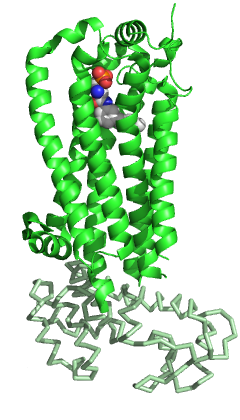
Back S1PR1 Welsh S1PR1 Persian S1PR1 ID S1PR1 Italian Сфингозин-1-фосфатный рецептор 1 Russian S1PR1 Serbo-Croatian S1PR1 Serbian S1PR1 Ukrainian
Sphingosine-1-phosphate receptor 1 (S1P receptor 1 or S1PR1), also known as endothelial differentiation gene 1 (EDG1) is a protein that in humans is encoded by the S1PR1 gene. S1PR1 is a G-protein-coupled receptor which binds the bioactive signaling molecule sphingosine 1-phosphate (S1P). S1PR1 belongs to a sphingosine-1-phosphate receptor subfamily comprising five members (S1PR1-5).[5] S1PR1 was originally identified as an abundant transcript in endothelial cells[6] and it has an important role in regulating endothelial cell cytoskeletal structure, migration, capillary-like network formation and vascular maturation.[7][8] In addition, S1PR1 signaling is important in the regulation of lymphocyte maturation, migration and trafficking.[9][10]
- ^ a b c GRCh38: Ensembl release 89: ENSG00000170989 – Ensembl, May 2017
- ^ a b c GRCm38: Ensembl release 89: ENSMUSG00000045092 – Ensembl, May 2017
- ^ "Human PubMed Reference:". National Center for Biotechnology Information, U.S. National Library of Medicine.
- ^ "Mouse PubMed Reference:". National Center for Biotechnology Information, U.S. National Library of Medicine.
- ^ Cite error: The named reference
Hanson_2012was invoked but never defined (see the help page). - ^ Hla T, Maciag T (June 1990). "An abundant transcript induced in differentiating human endothelial cells encodes a polypeptide with structural similarities to G-protein-coupled receptors". The Journal of Biological Chemistry. 265 (16): 9308–9313. doi:10.1016/S0021-9258(19)38849-0. PMID 2160972.
- ^ Lee MJ, Van Brocklyn JR, Thangada S, Liu CH, Hand AR, Menzeleev R, et al. (March 1998). "Sphingosine-1-phosphate as a ligand for the G protein-coupled receptor EDG-1". Science. 279 (5356): 1552–1555. Bibcode:1998Sci...279.1552L. doi:10.1126/science.279.5356.1552. PMID 9488656.
- ^ Liu CH, Thangada S, Lee MJ, Van Brocklyn JR, Spiegel S, Hla T (April 1999). "Ligand-induced trafficking of the sphingosine-1-phosphate receptor EDG-1". Molecular Biology of the Cell. 10 (4): 1179–1190. doi:10.1091/mbc.10.4.1179. PMC 25247. PMID 10198065.
- ^ Allende ML, Dreier JL, Mandala S, Proia RL (April 2004). "Expression of the sphingosine 1-phosphate receptor, S1P1, on T-cells controls thymic emigration". The Journal of Biological Chemistry. 279 (15): 15396–15401. doi:10.1074/jbc.M314291200. PMID 14732704.
- ^ Matloubian M, Lo CG, Cinamon G, Lesneski MJ, Xu Y, Brinkmann V, et al. (January 2004). "Lymphocyte egress from thymus and peripheral lymphoid organs is dependent on S1P receptor 1". Nature. 427 (6972): 355–360. Bibcode:2004Natur.427..355M. doi:10.1038/nature02284. PMID 14737169. S2CID 4371877.
© MMXXIII Rich X Search. We shall prevail. All rights reserved. Rich X Search





